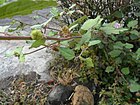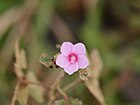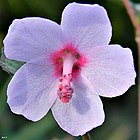Note: This is a project under development. The articles on this wiki are just being initiated and broadly incomplete. You can Help creating new pages.
Urena lobata
Urena lobata is a fast-growing, spreading, branched shrub that can reach a height of 4 - 5 metres. It is often treated as an annual, however, when it will reach a height of 0.5 - 2.5 metres and, if grown closely together, will not branch much.
Contents
[hide]- 1 Uses
- 2 Parts Used
- 3 Chemical Composition
- 4 Common names
- 5 Properties
- 6 Habit
- 7 Identification
- 8 List of Ayurvedic medicine in which the herb is used
- 9 Where to get the saplings
- 10 Mode of Propagation
- 11 How to plant/cultivate
- 12 Commonly seen growing in areas
- 13 Photo Gallery
- 14 References
- 15 External Links
Uses
Bowel complaints, Colic, Stomach-ache, Diarrhoea, Dysentery, Headache, Fractures, Wounds, Snake bites.[1]
Parts Used
Chemical Composition
It contains alkaloids, cardiac glycoside, tannins, terpenoid and saponin.[3]
Common names
| Language | Common name |
|---|---|
| Kannada | ದೊಡ್ಡ ಬೆಂಡೆ Dodda bende, ಕಾಡು ತುತ್ತಿ Kaadu thutthi |
| Hindi | Bachita, Lapetua |
| Malayalam | Oorppanam, Uram |
| Tamil | Ottu-t-tutti |
| Telugu | Nalla benda, Padanikaada |
| Marathi | Ran tupkuda, Vanbhendi |
| Gujarathi | Vagadau bhindo |
| Punjabi | NA |
| Kashmiri | NA |
| Sanskrit | Atibala, Bala |
| English | Aramina, Bur mallow |
Properties
Reference: Dravya - Substance, Rasa - Taste, Guna - Qualities, Veerya - Potency, Vipaka - Post-digesion effect, Karma - Pharmacological activity, Prabhava - Therepeutics.
Dravya
Rasa
Guna
Veerya
Vipaka
Karma
Prabhava
Habit
Identification
Leaf
| Kind | Shape | Feature |
|---|---|---|
Flower
| Type | Size | Color and composition | Stamen | More information |
|---|---|---|---|---|
| Flowering from July to January |
Fruit
| Type | Size | Mass | Appearance | Seeds | More information |
|---|---|---|---|---|---|
| Fruiting from July to January |
Other features
List of Ayurvedic medicine in which the herb is used
Where to get the saplings
Mode of Propagation
How to plant/cultivate
The plant has spread widely as a weed throughout the wet to semi-arid tropics and into the subtropics. It is sometimes cultivated as an annual in cooler climates.[6]
Commonly seen growing in areas
Roadsides, Waste places, Fallow fields, Plantations, Secondary growth.
Photo Gallery
References
- Jump up ↑ Indian Medicinal Plants by C.P.Khare
- Jump up ↑ ”Karnataka Medicinal Plants Volume-3” by Dr.M. R. Gurudeva, Page No.823, Published by Divyachandra Prakashana, #6/7, Kaalika Soudha, Balepete cross, Bengaluru
- Jump up ↑ Chemical constituents
- Jump up ↑ Common names
- Jump up ↑ [Morphology]
- Jump up ↑ Cultivation details
External Links
- Ayurvedic Herbs known to be helpful to treat Bowel complaints
- Ayurvedic Herbs known to be helpful to treat Colic
- Ayurvedic Herbs known to be helpful to treat Stomach-ache
- Ayurvedic Herbs known to be helpful to treat Diarrhoea
- Ayurvedic Herbs known to be helpful to treat Dysentery
- Ayurvedic Herbs known to be helpful to treat Headache
- Ayurvedic Herbs known to be helpful to treat Fractures
- Ayurvedic Herbs known to be helpful to treat Wounds
- Ayurvedic Herbs known to be helpful to treat Snake bites
- Herbs with Root used in medicine
- Herbs with Stem used in medicine
- Herbs with Leaf used in medicine
- Herbs with common name in Kannada
- Herbs with common name in Hindi
- Herbs with common name in Malayalam
- Herbs with common name in Tamil
- Herbs with common name in Telugu
- Herbs with common name in Marathi
- Herbs with common name in Gujarathi
- Herbs with common name in Sanskrit
- Herbs with common name in English
- Habit - Shrub
- Index of Plants which can be propagated by Seeds
- Herbs that are commonly seen in the region of Roadsides
- Herbs that are commonly seen in the region of Waste places
- Herbs that are commonly seen in the region of Fallow fields
- Herbs that are commonly seen in the region of Plantations
- Herbs that are commonly seen in the region of Secondary growth
- Herbs





